Globalisation and Mass Media During COVID-19: A UK Case Study Report
VerifiedAdded on 2023/06/15
|8
|2011
|217
Report
AI Summary
This report discusses the impact and role of mass media during the COVID-19 pandemic, focusing on a UK case study. It highlights how the spread of misinformation, amplified on digital platforms and social media, posed a significant threat to public health. The study explores how media and technology advancements were used to keep people connected and informed, while also contributing to the 'infodemic'. It examines the role of traditional and social media in disseminating news, opinions, and perceptions related to the pandemic, covering diverse issues such as the economy, health, welfare, and politics. Furthermore, the report addresses the challenges of information credibility on social media platforms and the management of the infodemic, emphasizing the importance of verifying information sources and understanding the reasons behind misinformation spread.
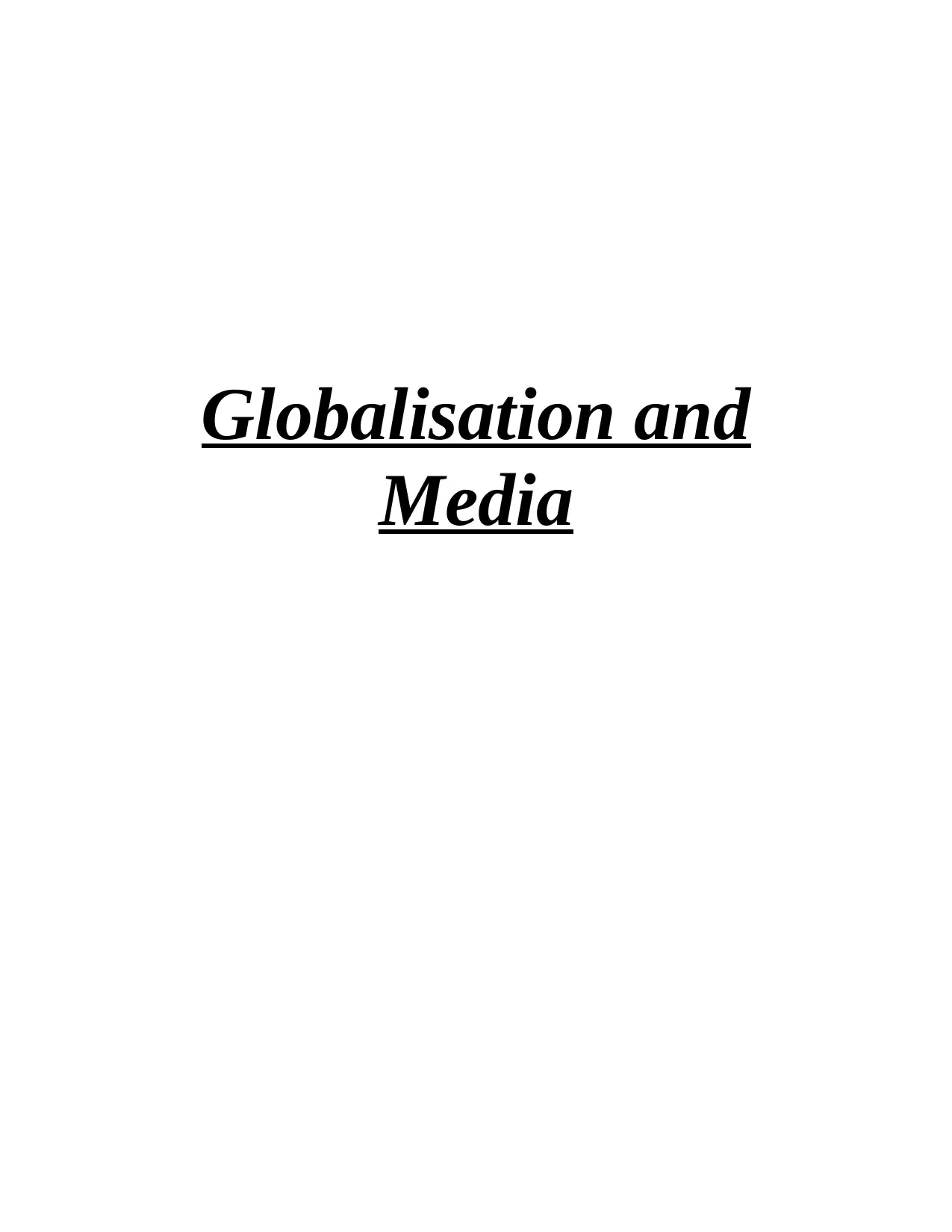
Globalisation and
Media
Media
Paraphrase This Document
Need a fresh take? Get an instant paraphrase of this document with our AI Paraphraser
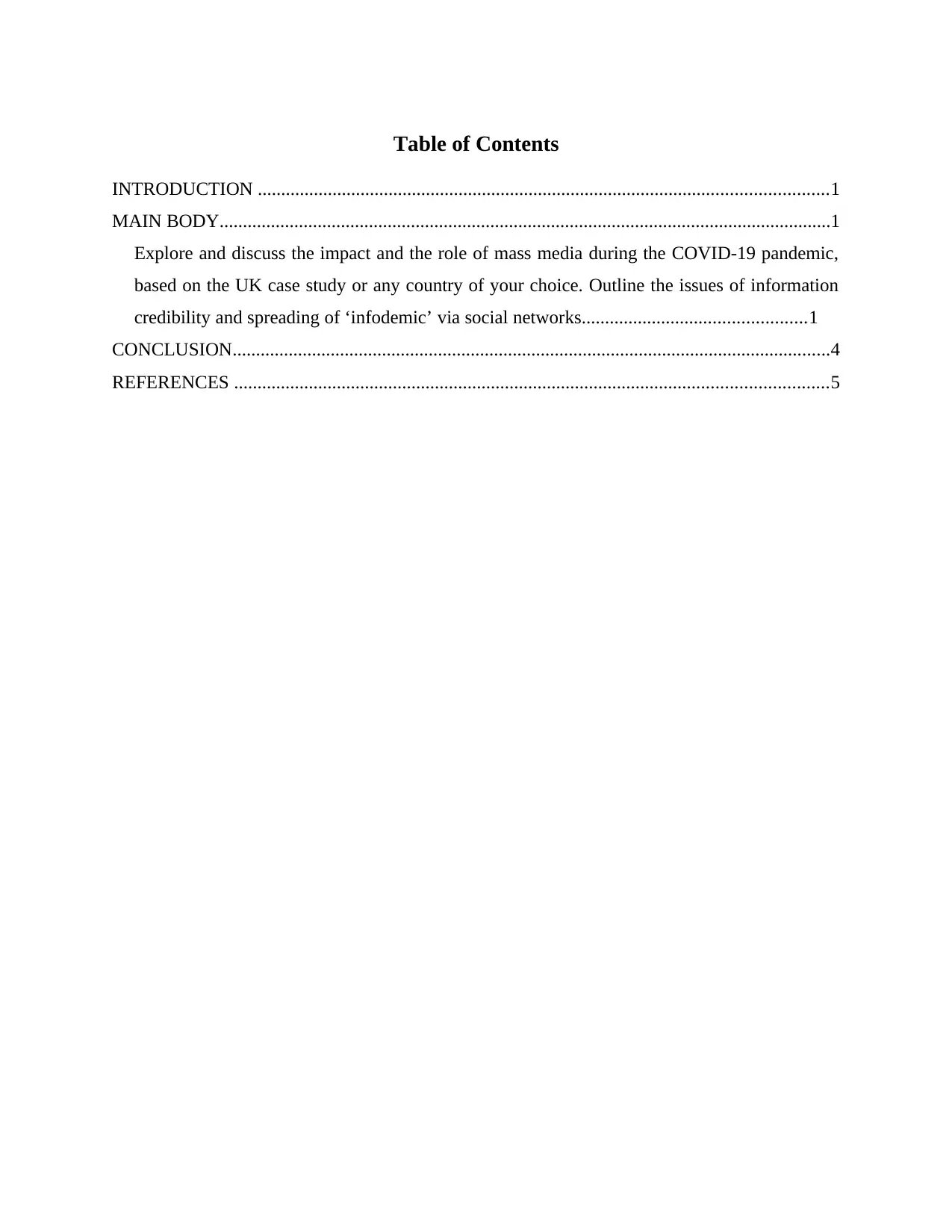
Table of Contents
INTRODUCTION ..........................................................................................................................1
MAIN BODY...................................................................................................................................1
Explore and discuss the impact and the role of mass media during the COVID-19 pandemic,
based on the UK case study or any country of your choice. Outline the issues of information
credibility and spreading of ‘infodemic’ via social networks................................................1
CONCLUSION................................................................................................................................4
REFERENCES ...............................................................................................................................5
INTRODUCTION ..........................................................................................................................1
MAIN BODY...................................................................................................................................1
Explore and discuss the impact and the role of mass media during the COVID-19 pandemic,
based on the UK case study or any country of your choice. Outline the issues of information
credibility and spreading of ‘infodemic’ via social networks................................................1
CONCLUSION................................................................................................................................4
REFERENCES ...............................................................................................................................5
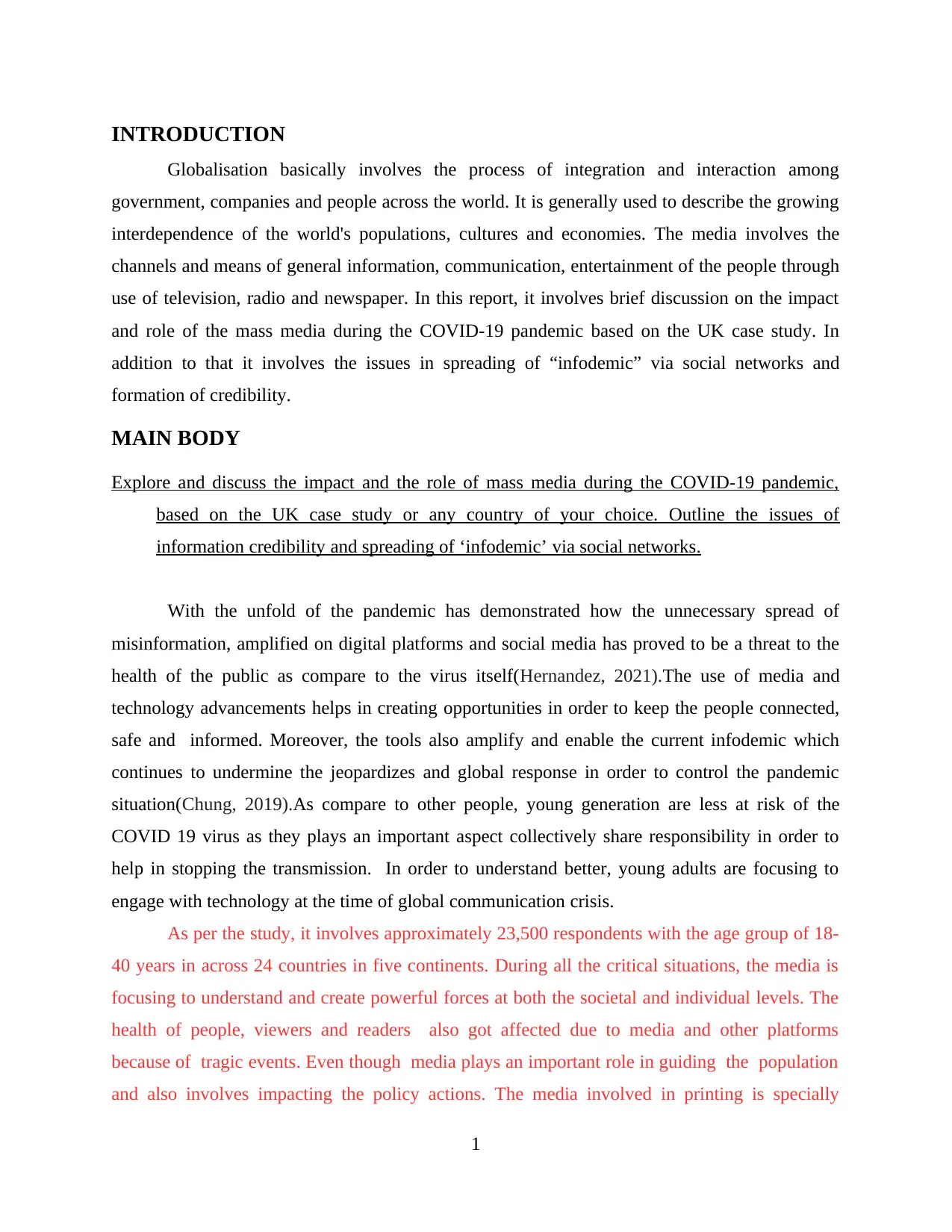
INTRODUCTION
Globalisation basically involves the process of integration and interaction among
government, companies and people across the world. It is generally used to describe the growing
interdependence of the world's populations, cultures and economies. The media involves the
channels and means of general information, communication, entertainment of the people through
use of television, radio and newspaper. In this report, it involves brief discussion on the impact
and role of the mass media during the COVID-19 pandemic based on the UK case study. In
addition to that it involves the issues in spreading of “infodemic” via social networks and
formation of credibility.
MAIN BODY
Explore and discuss the impact and the role of mass media during the COVID-19 pandemic,
based on the UK case study or any country of your choice. Outline the issues of
information credibility and spreading of ‘infodemic’ via social networks.
With the unfold of the pandemic has demonstrated how the unnecessary spread of
misinformation, amplified on digital platforms and social media has proved to be a threat to the
health of the public as compare to the virus itself(Hernandez, 2021).The use of media and
technology advancements helps in creating opportunities in order to keep the people connected,
safe and informed. Moreover, the tools also amplify and enable the current infodemic which
continues to undermine the jeopardizes and global response in order to control the pandemic
situation(Chung, 2019).As compare to other people, young generation are less at risk of the
COVID 19 virus as they plays an important aspect collectively share responsibility in order to
help in stopping the transmission. In order to understand better, young adults are focusing to
engage with technology at the time of global communication crisis.
As per the study, it involves approximately 23,500 respondents with the age group of 18-
40 years in across 24 countries in five continents. During all the critical situations, the media is
focusing to understand and create powerful forces at both the societal and individual levels. The
health of people, viewers and readers also got affected due to media and other platforms
because of tragic events. Even though media plays an important role in guiding the population
and also involves impacting the policy actions. The media involved in printing is specially
1
Globalisation basically involves the process of integration and interaction among
government, companies and people across the world. It is generally used to describe the growing
interdependence of the world's populations, cultures and economies. The media involves the
channels and means of general information, communication, entertainment of the people through
use of television, radio and newspaper. In this report, it involves brief discussion on the impact
and role of the mass media during the COVID-19 pandemic based on the UK case study. In
addition to that it involves the issues in spreading of “infodemic” via social networks and
formation of credibility.
MAIN BODY
Explore and discuss the impact and the role of mass media during the COVID-19 pandemic,
based on the UK case study or any country of your choice. Outline the issues of
information credibility and spreading of ‘infodemic’ via social networks.
With the unfold of the pandemic has demonstrated how the unnecessary spread of
misinformation, amplified on digital platforms and social media has proved to be a threat to the
health of the public as compare to the virus itself(Hernandez, 2021).The use of media and
technology advancements helps in creating opportunities in order to keep the people connected,
safe and informed. Moreover, the tools also amplify and enable the current infodemic which
continues to undermine the jeopardizes and global response in order to control the pandemic
situation(Chung, 2019).As compare to other people, young generation are less at risk of the
COVID 19 virus as they plays an important aspect collectively share responsibility in order to
help in stopping the transmission. In order to understand better, young adults are focusing to
engage with technology at the time of global communication crisis.
As per the study, it involves approximately 23,500 respondents with the age group of 18-
40 years in across 24 countries in five continents. During all the critical situations, the media is
focusing to understand and create powerful forces at both the societal and individual levels. The
health of people, viewers and readers also got affected due to media and other platforms
because of tragic events. Even though media plays an important role in guiding the population
and also involves impacting the policy actions. The media involved in printing is specially
1
⊘ This is a preview!⊘
Do you want full access?
Subscribe today to unlock all pages.

Trusted by 1+ million students worldwide
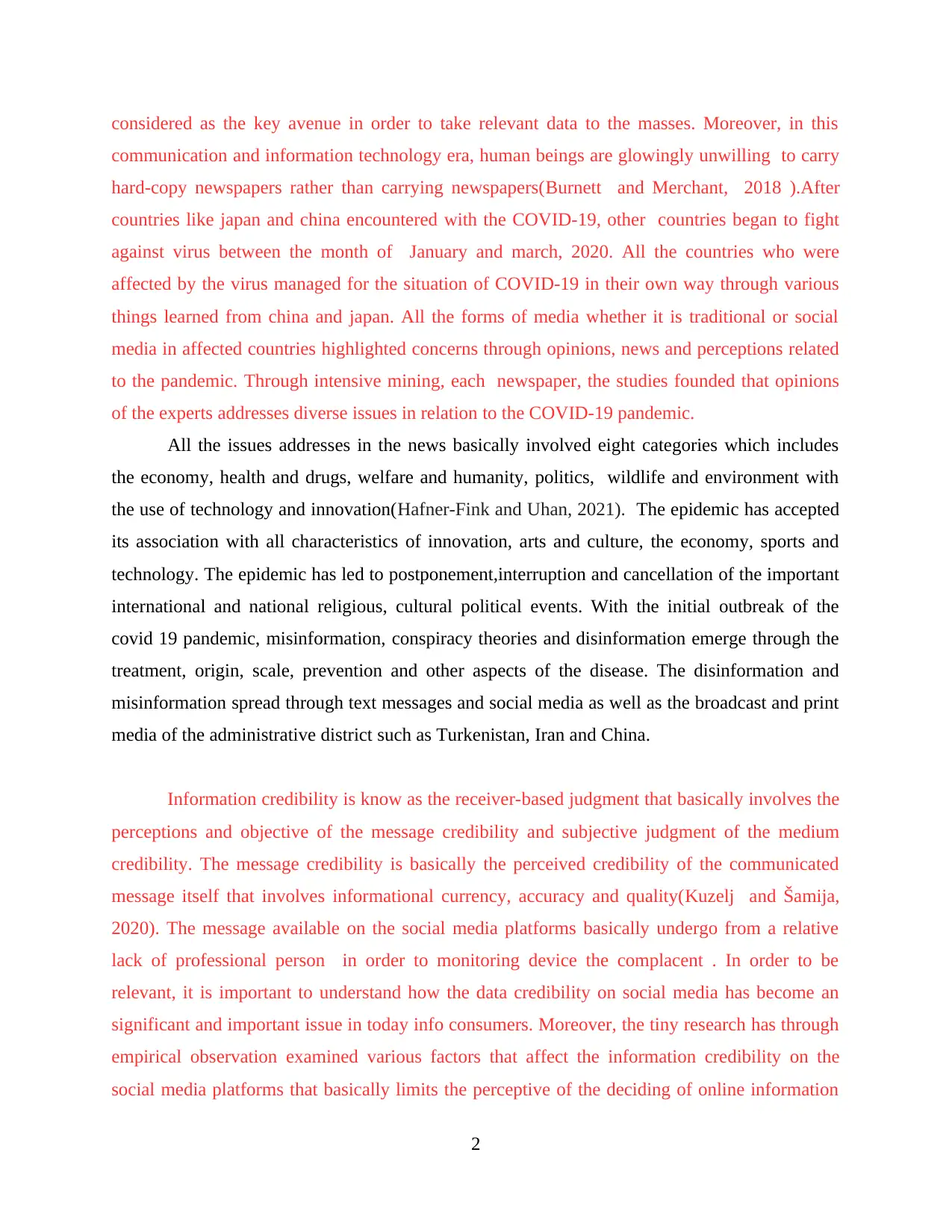
considered as the key avenue in order to take relevant data to the masses. Moreover, in this
communication and information technology era, human beings are glowingly unwilling to carry
hard-copy newspapers rather than carrying newspapers(Burnett and Merchant, 2018 ).After
countries like japan and china encountered with the COVID-19, other countries began to fight
against virus between the month of January and march, 2020. All the countries who were
affected by the virus managed for the situation of COVID-19 in their own way through various
things learned from china and japan. All the forms of media whether it is traditional or social
media in affected countries highlighted concerns through opinions, news and perceptions related
to the pandemic. Through intensive mining, each newspaper, the studies founded that opinions
of the experts addresses diverse issues in relation to the COVID-19 pandemic.
All the issues addresses in the news basically involved eight categories which includes
the economy, health and drugs, welfare and humanity, politics, wildlife and environment with
the use of technology and innovation(Hafner-Fink and Uhan, 2021). The epidemic has accepted
its association with all characteristics of innovation, arts and culture, the economy, sports and
technology. The epidemic has led to postponement,interruption and cancellation of the important
international and national religious, cultural political events. With the initial outbreak of the
covid 19 pandemic, misinformation, conspiracy theories and disinformation emerge through the
treatment, origin, scale, prevention and other aspects of the disease. The disinformation and
misinformation spread through text messages and social media as well as the broadcast and print
media of the administrative district such as Turkenistan, Iran and China.
Information credibility is know as the receiver-based judgment that basically involves the
perceptions and objective of the message credibility and subjective judgment of the medium
credibility. The message credibility is basically the perceived credibility of the communicated
message itself that involves informational currency, accuracy and quality(Kuzelj and Šamija,
2020). The message available on the social media platforms basically undergo from a relative
lack of professional person in order to monitoring device the complacent . In order to be
relevant, it is important to understand how the data credibility on social media has become an
significant and important issue in today info consumers. Moreover, the tiny research has through
empirical observation examined various factors that affect the information credibility on the
social media platforms that basically limits the perceptive of the deciding of online information
2
communication and information technology era, human beings are glowingly unwilling to carry
hard-copy newspapers rather than carrying newspapers(Burnett and Merchant, 2018 ).After
countries like japan and china encountered with the COVID-19, other countries began to fight
against virus between the month of January and march, 2020. All the countries who were
affected by the virus managed for the situation of COVID-19 in their own way through various
things learned from china and japan. All the forms of media whether it is traditional or social
media in affected countries highlighted concerns through opinions, news and perceptions related
to the pandemic. Through intensive mining, each newspaper, the studies founded that opinions
of the experts addresses diverse issues in relation to the COVID-19 pandemic.
All the issues addresses in the news basically involved eight categories which includes
the economy, health and drugs, welfare and humanity, politics, wildlife and environment with
the use of technology and innovation(Hafner-Fink and Uhan, 2021). The epidemic has accepted
its association with all characteristics of innovation, arts and culture, the economy, sports and
technology. The epidemic has led to postponement,interruption and cancellation of the important
international and national religious, cultural political events. With the initial outbreak of the
covid 19 pandemic, misinformation, conspiracy theories and disinformation emerge through the
treatment, origin, scale, prevention and other aspects of the disease. The disinformation and
misinformation spread through text messages and social media as well as the broadcast and print
media of the administrative district such as Turkenistan, Iran and China.
Information credibility is know as the receiver-based judgment that basically involves the
perceptions and objective of the message credibility and subjective judgment of the medium
credibility. The message credibility is basically the perceived credibility of the communicated
message itself that involves informational currency, accuracy and quality(Kuzelj and Šamija,
2020). The message available on the social media platforms basically undergo from a relative
lack of professional person in order to monitoring device the complacent . In order to be
relevant, it is important to understand how the data credibility on social media has become an
significant and important issue in today info consumers. Moreover, the tiny research has through
empirical observation examined various factors that affect the information credibility on the
social media platforms that basically limits the perceptive of the deciding of online information
2
Paraphrase This Document
Need a fresh take? Get an instant paraphrase of this document with our AI Paraphraser
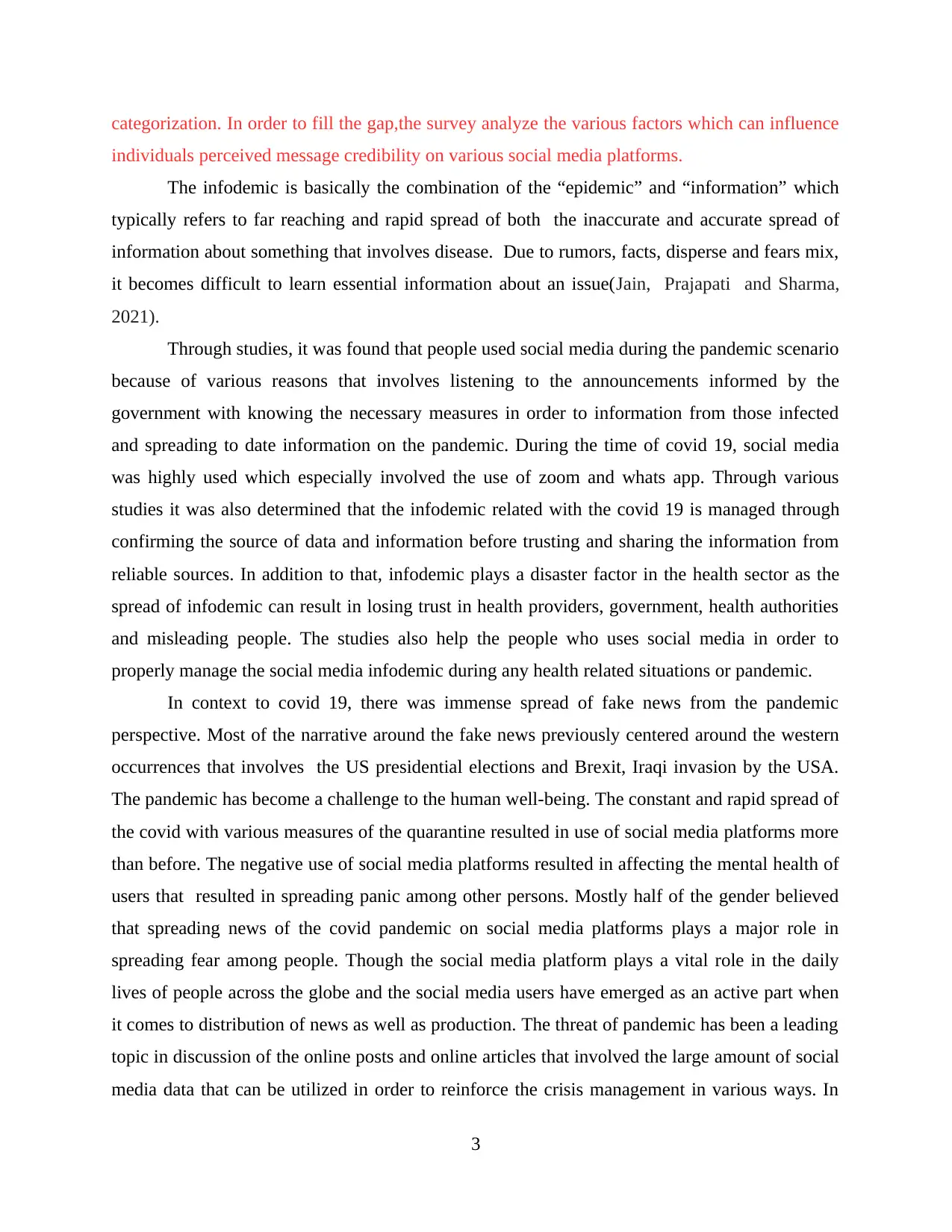
categorization. In order to fill the gap,the survey analyze the various factors which can influence
individuals perceived message credibility on various social media platforms.
The infodemic is basically the combination of the “epidemic” and “information” which
typically refers to far reaching and rapid spread of both the inaccurate and accurate spread of
information about something that involves disease. Due to rumors, facts, disperse and fears mix,
it becomes difficult to learn essential information about an issue(Jain, Prajapati and Sharma,
2021).
Through studies, it was found that people used social media during the pandemic scenario
because of various reasons that involves listening to the announcements informed by the
government with knowing the necessary measures in order to information from those infected
and spreading to date information on the pandemic. During the time of covid 19, social media
was highly used which especially involved the use of zoom and whats app. Through various
studies it was also determined that the infodemic related with the covid 19 is managed through
confirming the source of data and information before trusting and sharing the information from
reliable sources. In addition to that, infodemic plays a disaster factor in the health sector as the
spread of infodemic can result in losing trust in health providers, government, health authorities
and misleading people. The studies also help the people who uses social media in order to
properly manage the social media infodemic during any health related situations or pandemic.
In context to covid 19, there was immense spread of fake news from the pandemic
perspective. Most of the narrative around the fake news previously centered around the western
occurrences that involves the US presidential elections and Brexit, Iraqi invasion by the USA.
The pandemic has become a challenge to the human well-being. The constant and rapid spread of
the covid with various measures of the quarantine resulted in use of social media platforms more
than before. The negative use of social media platforms resulted in affecting the mental health of
users that resulted in spreading panic among other persons. Mostly half of the gender believed
that spreading news of the covid pandemic on social media platforms plays a major role in
spreading fear among people. Though the social media platform plays a vital role in the daily
lives of people across the globe and the social media users have emerged as an active part when
it comes to distribution of news as well as production. The threat of pandemic has been a leading
topic in discussion of the online posts and online articles that involved the large amount of social
media data that can be utilized in order to reinforce the crisis management in various ways. In
3
individuals perceived message credibility on various social media platforms.
The infodemic is basically the combination of the “epidemic” and “information” which
typically refers to far reaching and rapid spread of both the inaccurate and accurate spread of
information about something that involves disease. Due to rumors, facts, disperse and fears mix,
it becomes difficult to learn essential information about an issue(Jain, Prajapati and Sharma,
2021).
Through studies, it was found that people used social media during the pandemic scenario
because of various reasons that involves listening to the announcements informed by the
government with knowing the necessary measures in order to information from those infected
and spreading to date information on the pandemic. During the time of covid 19, social media
was highly used which especially involved the use of zoom and whats app. Through various
studies it was also determined that the infodemic related with the covid 19 is managed through
confirming the source of data and information before trusting and sharing the information from
reliable sources. In addition to that, infodemic plays a disaster factor in the health sector as the
spread of infodemic can result in losing trust in health providers, government, health authorities
and misleading people. The studies also help the people who uses social media in order to
properly manage the social media infodemic during any health related situations or pandemic.
In context to covid 19, there was immense spread of fake news from the pandemic
perspective. Most of the narrative around the fake news previously centered around the western
occurrences that involves the US presidential elections and Brexit, Iraqi invasion by the USA.
The pandemic has become a challenge to the human well-being. The constant and rapid spread of
the covid with various measures of the quarantine resulted in use of social media platforms more
than before. The negative use of social media platforms resulted in affecting the mental health of
users that resulted in spreading panic among other persons. Mostly half of the gender believed
that spreading news of the covid pandemic on social media platforms plays a major role in
spreading fear among people. Though the social media platform plays a vital role in the daily
lives of people across the globe and the social media users have emerged as an active part when
it comes to distribution of news as well as production. The threat of pandemic has been a leading
topic in discussion of the online posts and online articles that involved the large amount of social
media data that can be utilized in order to reinforce the crisis management in various ways. In
3
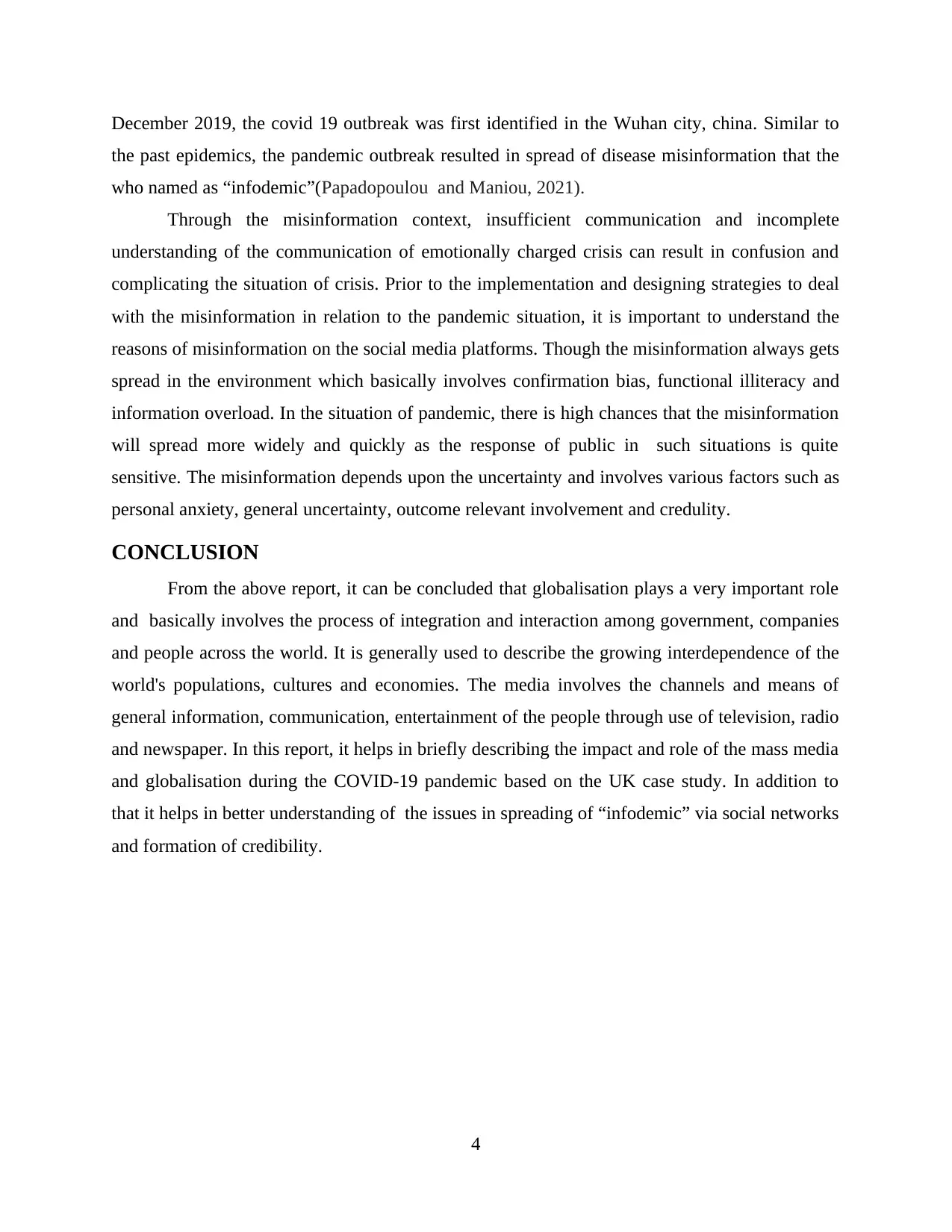
December 2019, the covid 19 outbreak was first identified in the Wuhan city, china. Similar to
the past epidemics, the pandemic outbreak resulted in spread of disease misinformation that the
who named as “infodemic”(Papadopoulou and Maniou, 2021).
Through the misinformation context, insufficient communication and incomplete
understanding of the communication of emotionally charged crisis can result in confusion and
complicating the situation of crisis. Prior to the implementation and designing strategies to deal
with the misinformation in relation to the pandemic situation, it is important to understand the
reasons of misinformation on the social media platforms. Though the misinformation always gets
spread in the environment which basically involves confirmation bias, functional illiteracy and
information overload. In the situation of pandemic, there is high chances that the misinformation
will spread more widely and quickly as the response of public in such situations is quite
sensitive. The misinformation depends upon the uncertainty and involves various factors such as
personal anxiety, general uncertainty, outcome relevant involvement and credulity.
CONCLUSION
From the above report, it can be concluded that globalisation plays a very important role
and basically involves the process of integration and interaction among government, companies
and people across the world. It is generally used to describe the growing interdependence of the
world's populations, cultures and economies. The media involves the channels and means of
general information, communication, entertainment of the people through use of television, radio
and newspaper. In this report, it helps in briefly describing the impact and role of the mass media
and globalisation during the COVID-19 pandemic based on the UK case study. In addition to
that it helps in better understanding of the issues in spreading of “infodemic” via social networks
and formation of credibility.
4
the past epidemics, the pandemic outbreak resulted in spread of disease misinformation that the
who named as “infodemic”(Papadopoulou and Maniou, 2021).
Through the misinformation context, insufficient communication and incomplete
understanding of the communication of emotionally charged crisis can result in confusion and
complicating the situation of crisis. Prior to the implementation and designing strategies to deal
with the misinformation in relation to the pandemic situation, it is important to understand the
reasons of misinformation on the social media platforms. Though the misinformation always gets
spread in the environment which basically involves confirmation bias, functional illiteracy and
information overload. In the situation of pandemic, there is high chances that the misinformation
will spread more widely and quickly as the response of public in such situations is quite
sensitive. The misinformation depends upon the uncertainty and involves various factors such as
personal anxiety, general uncertainty, outcome relevant involvement and credulity.
CONCLUSION
From the above report, it can be concluded that globalisation plays a very important role
and basically involves the process of integration and interaction among government, companies
and people across the world. It is generally used to describe the growing interdependence of the
world's populations, cultures and economies. The media involves the channels and means of
general information, communication, entertainment of the people through use of television, radio
and newspaper. In this report, it helps in briefly describing the impact and role of the mass media
and globalisation during the COVID-19 pandemic based on the UK case study. In addition to
that it helps in better understanding of the issues in spreading of “infodemic” via social networks
and formation of credibility.
4
⊘ This is a preview!⊘
Do you want full access?
Subscribe today to unlock all pages.

Trusted by 1+ million students worldwide
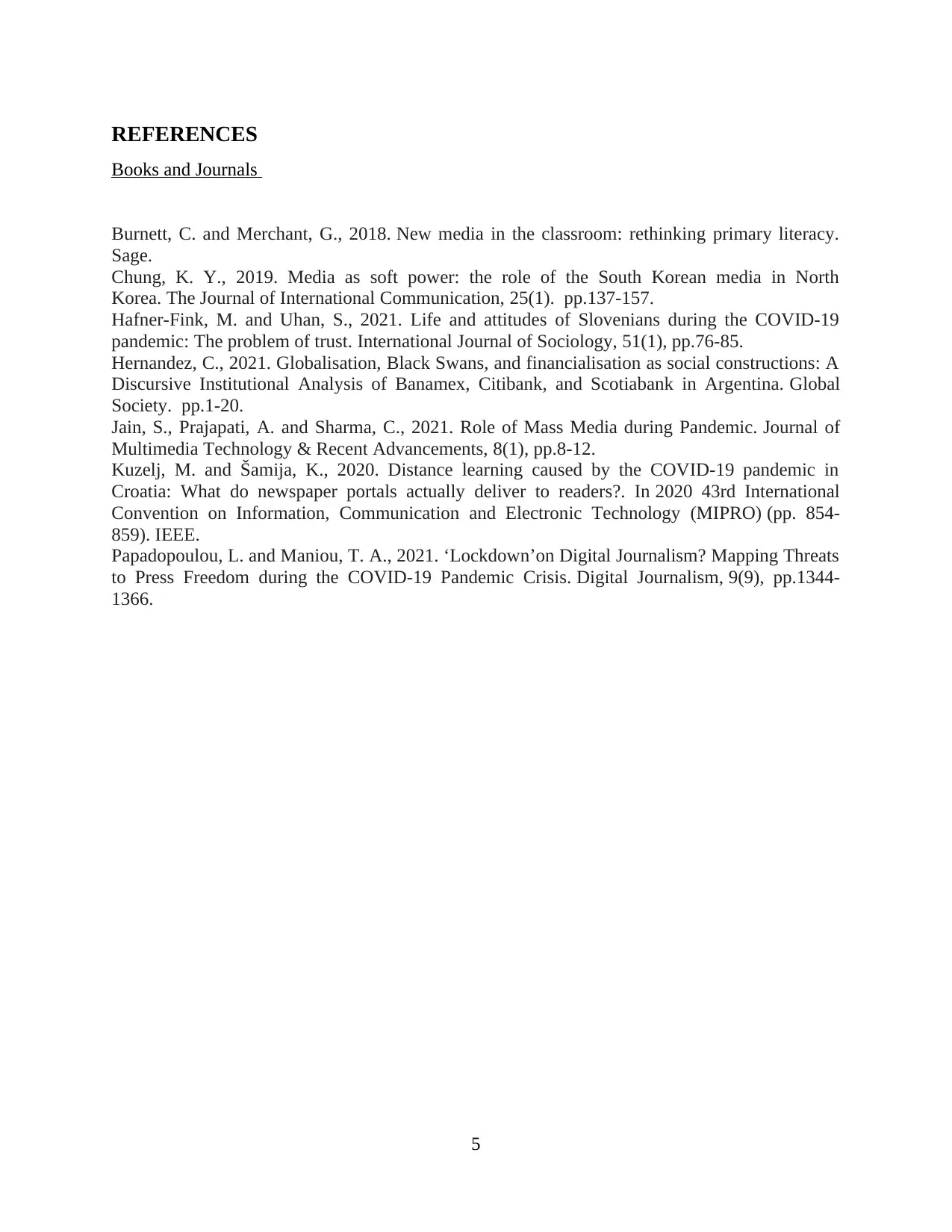
REFERENCES
Books and Journals
Burnett, C. and Merchant, G., 2018. New media in the classroom: rethinking primary literacy.
Sage.
Chung, K. Y., 2019. Media as soft power: the role of the South Korean media in North
Korea. The Journal of International Communication, 25(1). pp.137-157.
Hafner-Fink, M. and Uhan, S., 2021. Life and attitudes of Slovenians during the COVID-19
pandemic: The problem of trust. International Journal of Sociology, 51(1), pp.76-85.
Hernandez, C., 2021. Globalisation, Black Swans, and financialisation as social constructions: A
Discursive Institutional Analysis of Banamex, Citibank, and Scotiabank in Argentina. Global
Society. pp.1-20.
Jain, S., Prajapati, A. and Sharma, C., 2021. Role of Mass Media during Pandemic. Journal of
Multimedia Technology & Recent Advancements, 8(1), pp.8-12.
Kuzelj, M. and Šamija, K., 2020. Distance learning caused by the COVID-19 pandemic in
Croatia: What do newspaper portals actually deliver to readers?. In 2020 43rd International
Convention on Information, Communication and Electronic Technology (MIPRO) (pp. 854-
859). IEEE.
Papadopoulou, L. and Maniou, T. A., 2021. ‘Lockdown’on Digital Journalism? Mapping Threats
to Press Freedom during the COVID-19 Pandemic Crisis. Digital Journalism, 9(9), pp.1344-
1366.
5
Books and Journals
Burnett, C. and Merchant, G., 2018. New media in the classroom: rethinking primary literacy.
Sage.
Chung, K. Y., 2019. Media as soft power: the role of the South Korean media in North
Korea. The Journal of International Communication, 25(1). pp.137-157.
Hafner-Fink, M. and Uhan, S., 2021. Life and attitudes of Slovenians during the COVID-19
pandemic: The problem of trust. International Journal of Sociology, 51(1), pp.76-85.
Hernandez, C., 2021. Globalisation, Black Swans, and financialisation as social constructions: A
Discursive Institutional Analysis of Banamex, Citibank, and Scotiabank in Argentina. Global
Society. pp.1-20.
Jain, S., Prajapati, A. and Sharma, C., 2021. Role of Mass Media during Pandemic. Journal of
Multimedia Technology & Recent Advancements, 8(1), pp.8-12.
Kuzelj, M. and Šamija, K., 2020. Distance learning caused by the COVID-19 pandemic in
Croatia: What do newspaper portals actually deliver to readers?. In 2020 43rd International
Convention on Information, Communication and Electronic Technology (MIPRO) (pp. 854-
859). IEEE.
Papadopoulou, L. and Maniou, T. A., 2021. ‘Lockdown’on Digital Journalism? Mapping Threats
to Press Freedom during the COVID-19 Pandemic Crisis. Digital Journalism, 9(9), pp.1344-
1366.
5
Paraphrase This Document
Need a fresh take? Get an instant paraphrase of this document with our AI Paraphraser

6
1 out of 8
Related Documents
Your All-in-One AI-Powered Toolkit for Academic Success.
+13062052269
info@desklib.com
Available 24*7 on WhatsApp / Email
![[object Object]](/_next/static/media/star-bottom.7253800d.svg)
Unlock your academic potential
Copyright © 2020–2025 A2Z Services. All Rights Reserved. Developed and managed by ZUCOL.





